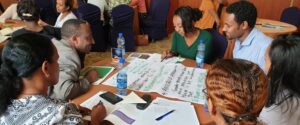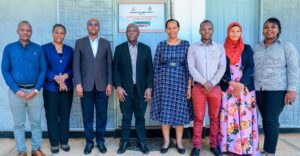MOOCs and educational development: Part 3
This is the third in a series of blog posts on MOOCs (massive open online courses).
In my previous post I wrote about my first few weeks learning in a biostatistics MOOC offered by edX/HarvardX. In this post I will focus on Internet bandwidth, given that the MOOC I took — and MOOCs in general — rely heavily on instructional videos.
After settling into the course, I reflected on how fortunate I was to be taking the course and have access to captivating instructional videos that I could watch using different options (described in my previous post). It was like being in the driver’s seat of a good car: you are in control and you enjoy the ride. But the quality of the ride depends on the road. So it is with online videos and bandwidth.
Good bandwidth and stable Internet connections cannot be taken for granted in developing countries. INASP have done some work in bandwidth management and optimisation, so we’re sensitive to this issue.
I happen to live in a developing country myself. I work from my home in Mumbai, India, and I have a broadband connection. It’s not bad but definitely not as fast as the broadband connection I had in the UK last year. I tried doing a speed test of my bandwidth: one website said that my “bandwidth reading” was 1.13 Mbps. Another website, speedtest.net, said that my download speed was 0.52 Mbps and upload speed was 0.51 Mbps. Both are not particularly impressive numbers, but I could watch the MOOC videos (which are hosted on YouTube) easily enough.
However, when I was in Chennai on vacation near the end of the course, I couldn’t watch the videos. My bandwidth reading was only around 400 Kbps. Although Chennai is a major city like Mumbai and there are no intrinsic problems with bandwidth, I suppose I was on a low-speed connection.
I remember logging on to the course one night from Chennai to begin watching the videos for that week and was dismayed to find that the videos just didn’t play. I had completed 10 weeks of the course and had become dependent on the videos, although equivalent handouts were provided every week. I read these handouts seriously for the first time in week 11 of the course. To my surprise, the handouts were illuminating enough for me to complete the problem set for that week. I scored 81% in that problem set, which was my lowest score among the 12 problem sets. On the other hand, I spent only a few hours on the course that week because reading documents is faster than watching videos (at least for me). By the way, I think I spent roughly 10 hours a week on the course during the other weeks, which was also the recommended study time.
Although I managed to cross that difficult week with handouts instead of videos, I was definitely fonder of the videos and I think they were central to the course experience.
To find out if and how other students in developing countries used the videos, I made a post on the course discussion forum asking about this. About 10 fellow students replied. Some had had experiences similar to mine with the videos: mostly good. A few people said that they downloaded the videos before watching them. They must have had to schedule both the downloading and the watching, which might have made the course more logistically difficult to manage. But the students who replied said that this approach had worked well for them.
Around the time I was taking the MOOC, I was in touch with an AuthorAID mentor in Australia who spoke highly about a Coursera MOOC on science writing that she had just completed. She mentioned that the videos used up too much of her bandwidth quota and so she had to use the reading material instead of the videos. I remember having a bandwidth quota in the UK (but this was not proving feasible and I soon upgraded to unlimited bandwidth). So the bandwidth issue with MOOCs is perhaps not confined to people in developing countries.
So on the whole I had enough bandwidth — and time on my hands. I went through the course and met the weekly deadlines for the problem sets. The passing score for each problem set was 85%, and I scored above this in all but one of the 12 sets. But throughout the course I couldn’t help worrying about the final exam.
In my next post, I’ll write about the final exam and the discussion forums in the course, which were enlightening and disturbing in equal measure.





Thanks, Ravi, for developing the perspective from the point of view of a MOOC user in the South. As big new developments like MOOCs get headlines in the North, we need more information on they play out for the millions approaching them with hope but also with low bandwidth, powercuts etc. Sue Corbett, Executive Director, INASP
Hi Sue – I fully agree with the context you have set. Many of the debates on MOOCs are happening in the North, and the implications of MOOCs for developing countries often don’t go deeper than “MOOCs will democratize education around the world” or, on the other extreme, “MOOCs are not right or not relevant for developing countries”. I’m trying to present a sort of empirical view of MOOCs from a Southern perspective, as you have mentioned.